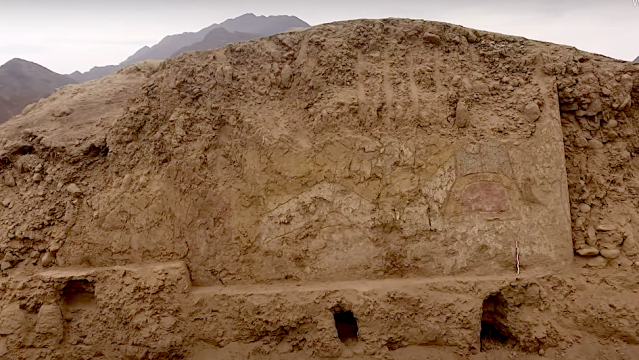It likely had eight legs, and at least one of them is still brandishing a knife. That’s the report from archaeologists in northern Peru, who have announced the discovery of a 15.24 m mural that once was the centrepiece of a pre-Columbian shrine.
The find was made in November 2020, when farmers seeking to expand their land partially destroyed a huaca — a Peruvian ceremonial structure — sitting among their avocado and sugar cane crops. The huaca, now cut in half, revealed a striking mural.
Máquinas excavadoras destruyeron un montículo de adobe (que no se conocía y que sería del período cupisnique) para ampliar tierras agrícolas. Sobrevivió un fragmento de mural. He forzado el contraste de la foto original para que se aprecie mejor el diseño. Detalles en enlace. https://t.co/rA4wPwuQmg pic.twitter.com/SVDM4t6jqT
— Antiguo Perú (@Antiguo_Peru) March 22, 2021
“What we have here is a shrine that would have been a ceremonial centre thousands of years ago,” Régulo Franco Jordán, one of the archaeologists who went about excavating and preserving the elements of the ancient artwork that hadn’t been demolished, told the Peruvian newspaper La República.
Jordán estimated the mural was about 3,200 years old and noted that about 60% of the huaca was destroyed. The archaeologists attribute the huaca and mural to the Cupisnique culture, which used spiders as a divine symbol. The Cupisnique inhabited the area, known today as the Virú Valley, for much of the Iron Age. In 2008, a fresco of a divine spider turned up in a temple attributed to the Cupisnique nearby, and other Cupisnique sites have yielded pottery adorned with arachnids.
This site, dubbed Tombalito by Jordán, abuts the Virú River on Peru’s northwestern coast. One can just make out a couple of the insect’s legs and the weapon it wields in one “hand.” The red, white, yellow, and grey pigments are just barely distinguishable from the khaki brown soil.
“The spider on the shrine is associated with water and was an incredibly important animal in pre-Hispanic cultures, which lived according to a ceremonial calendar,” Jordán told La Libertad. “It’s likely that there was a special, sacred water ceremony held between January and March when the rains came down from the higher areas.”
[referenced id=”1521107″ url=”https://gizmodo.com.au/2020/10/ancient-36-58-m-wide-drawing-of-cat-found-at-nazca-lines-site-in-peru/” thumb=”https://gizmodo.com.au/wp-content/uploads/2020/10/20/kjdnvwoq95kzynzp9fvi-300×168.jpg” title=”Ancient, 37 Metre-Wide Drawing of Cat Found at Nazca Lines Site in Peru” excerpt=”An oversized cat drawing has been discovered on a hill at the famous Nazca Lines site in Peru. The impressive artwork dates back some 2,000 years and measures over 36.58 metres across.”]
There are additional details at the corners of the exposed mural that suggest there is more Cupisnique artwork to uncover besides the sprawling spider. But the team will temporarily cover up the site and return to it for more excavation work as the ongoing pandemic allows.
In the meantime, the spider bits that weren’t harmed preside over the fields, as they thousands of years ago.
